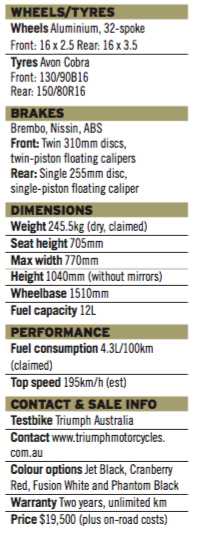I almost feel like a shirt and black tie would be appropriate attire while on what could feasibly be the classiest classic bike on the market today. It’s Triumph’s new Bonneville-based Speedmaster and, while Charley Boorman attended the Aussie launch of the new British twin in a bid to butter us up and sell the thing to us, this new rendition of a classic Triumph does a bloody good job of selling itself.
This bike fills a gap where there seemingly wasn’t one to fill.
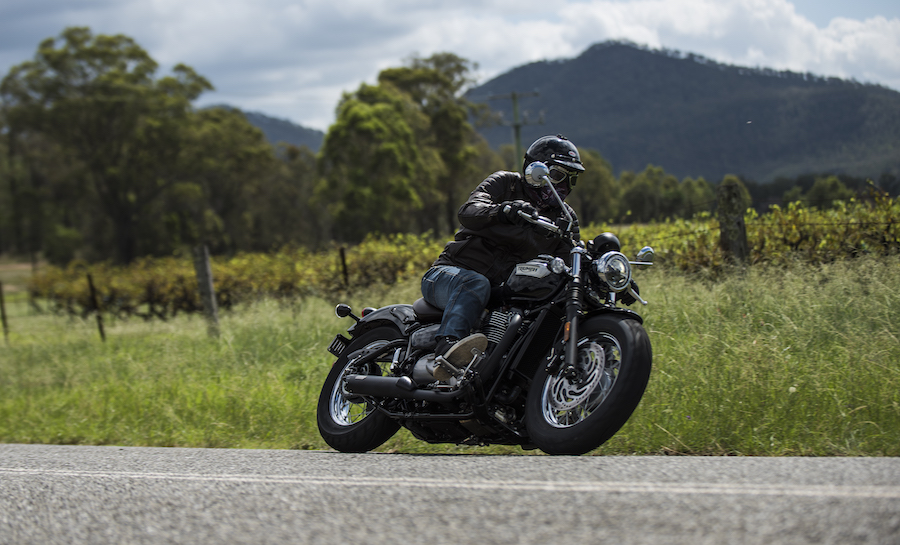
With the firm’s T100, T120, Bobber, Scrambler, Speed Twin, Thruxton and now the Speedmaster, you might be excused for thinking that this line of retro Triumphs has been done to death. However, as the Speedmaster proved to me, that’s simply not true.
Until you spend some time with the Speedy, it might be hard to see where she fits in.
I spent an entire day riding around some of the finest roads in New South Wales with Boorman and a bunch of Speedmasters, and it was as good a way as any to be introduced to Triumph’s latest hope.
Triumph says that, with the introduction of the new Bonneville generation, and specifically the Bonneville T120 and Bonneville Bobber, the choice has never been wider. These two models are the base for the others in the range; the T is the twin-shock variant and the very sexy Bobber platform is the variant with the hidden rear shock, resulting in a rigid rear-end look. It’s then various and clever styling cues that make the difference from one machine to the other. But ultimately they’re all based on one of the two.
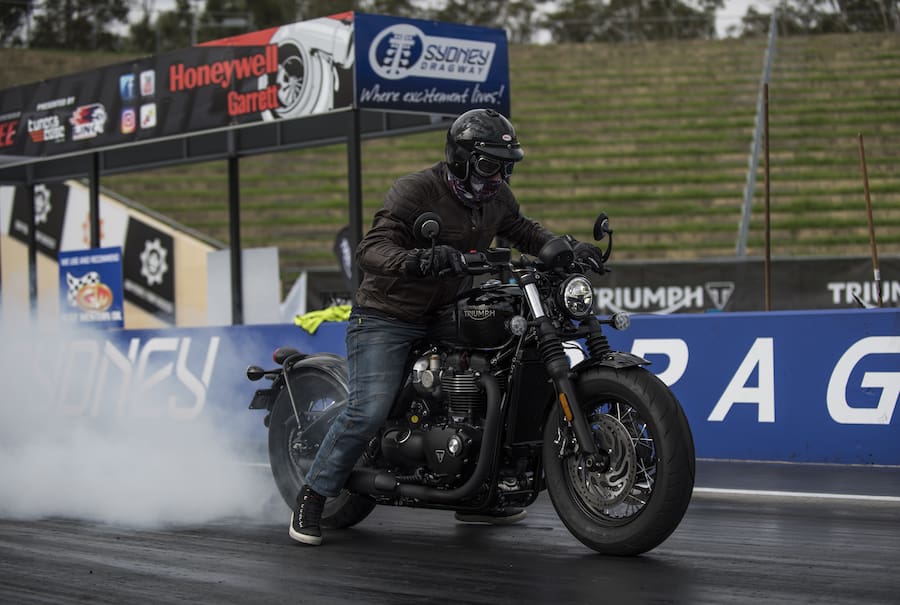
The new Bonneville Speedmaster, with its custom heritage and classic Triumph DNA, uses the Bobber as its starting point, not only employing the same frame and monoshock rear-end, but also the same water-cooled parallel-twin motor. But that’s where the similarities end.
The Speedmaster in standard form is a more practical version of the Bobber, with a different seating position, the ability to carry a pillion, a bigger fuel tank and authentic-looking swept-back custom beach bars.
Using the same Bonneville 1200cc High Torque engine as the Bobber, the Speedmaster has an edge over its roadster competition. Its 106Nm at 4000rpm torque figure gives it an edge on paper, but it’s where the torque chimes in that is important and impressive. A flat curve from virtually 2500rpm means that this twin is a plodder in its purest form. It loves working at low revs and I often found myself pulling one or even two gears too high, just to revel in the unique sound and feel of the ride.

Peak power of 77hp (57kW) at just over 6000rpm is modest considering its 1200cc capacity, but the Speedmaster isn’t about big power numbers, and Triumph’s design crew never went chasing them.In saying that, it has up to 10 per cent more torque and power than the current-generation Bonneville T120, proving that development never really stands still.
The engineers tuned this bike for smooth and precise throttle response, and it achieved its goal thanks to the well-modulated fly-by-wire throttle. The last 1200cc High Torque-engined bike I rode had quite a jerky throttle, but with Triumph continually updating the ECU from model to model (and at service time), I can say now it’s very smooth on and off the throttle, which makes it much more enjoyable to ride than when this system first hit the market.

There are many well-considered design ideas that keep things out of sight for a clean look and classy finish. The water pipes are all internal, giving the naked Speedmaster an old-school air-cooled look. Even the radiator is tucked up between the frame rails and is well out of sight.
The catalytic converter, which helps the bike meet Euro 4, is tucked up underneath and the wiring is also well hidden. The twin throttle bodies are concealed behind old-school Amal carb outers that keep the ’50s theme believable, as does the similarly themed battery box on the left-hand side.
The bottom-end is new. It sports a slick six-speed gearbox that never once missed a gear, no matter how sloppy or lazy I was.
The gear ratios are very wide, giving the engine a lot of scope to work within. You can use fourth gear at 100km/h but, with fifth longer and sixth an overdrive gear, there are plenty of options to ride the bike in a way that suits your mood. Finding neutral was never a problem, which is important if much of your riding is done in traffic.
The engine is perfectly smooth due to the diametrically opposed balancers, but there’s no getting away from the feeling a 270-degree crank delivers. It’s an emotional power that seems to push the bike forward with every beat, and every beat makes the user smile just that little bit more. And I would say Triumph must have put a lot of effort into tuning the pipe not only for power, but for the perfect sound as well.

The clutch is also impressive. It works as a conventional slipper clutch, or back-torque clutch in this case, but under acceleration it has another set of ramps that tightens the clutch pack together, so the harder you go the less chance the clutch has of slipping. That allows three springs to be used instead of the usual six, and that makes the clutch action much lighter, which is great around town.
Built around the Bobber platform, the Speedmaster highlights the firm’s versatility. Until you look closely, it’s hard to believe they are the same base bike. It uses the same chassis and black powder-coated cage swingarm (complete with paddock-stand bobbin mounts).
It’s hard to detect the hidden monoshock tucked away under the seat, but it absorbs the bumps very well. Operated by a linkage, it boasts 73mm of rear-wheel travel, and a preload adjuster makes it possible to beef the standard shock up if you put gear or a pillion on the back.
The rear shock works better than the standard Bobber item. I didn’t once bottom out the rear of the Speedmaster, whereas the standard Bobber I rode the day before had me wishing I still had two kidneys instead of one, such was the severity of the occasional jarring.
The front-end employs a 41mm cartridge fork with 90mm of travel and, although non-adjustable, it offers good feel and is well balanced.
We rode more than 400km along the Putty Road northwest of Sydney and then over to the Old Pacific Highway, both notoriously fun stretches of road, and the suspension met my demands and created a very neutral and balanced feel, which made the Speedmaster easy to ride.
A pair of 310mm discs with twin-piston Brembo calipers are mounted up front and are a definite advantage compared to the single-disc classics Triumph has released in the past. There’s no fade and a decent squeeze of the lever will get the front wheel chirping as the ABS cuts in.
The single 255mm rear disc brake with single-piston Nissin caliper never faded either and gave a good amount of feel, which is the most important asset for a rear brake.
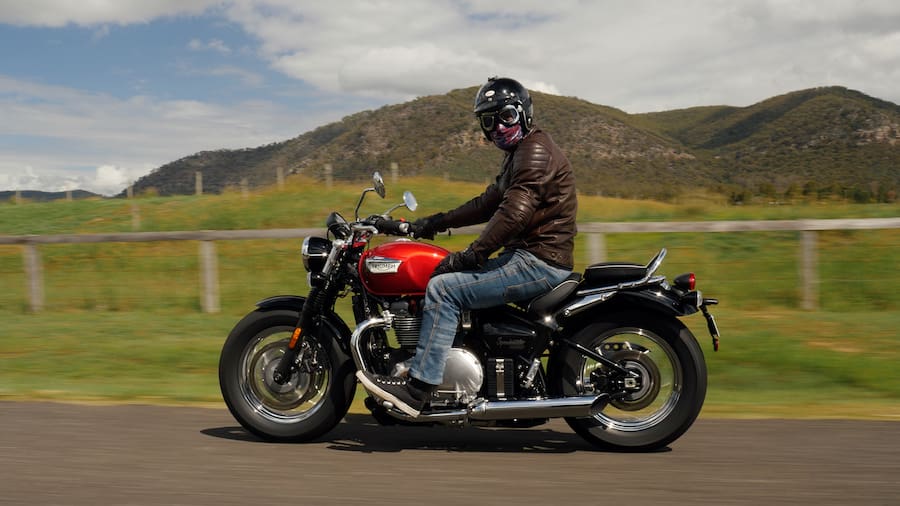
In terms of technology, the Speedmaster is up there with the best and, as far as this genre of bikes go, it’s probably the most advanced in its class. The bike is fitted with LED lights all round and the headlight has a distinctive daytime running light pattern.
I’ve already talked about the fly-by-wire system, but it does more than just smooth out throttle response, it also controls the switchable mapping (Rain and Road), which is selected by the mode button on the right-hand switchblock.
The Road setting gives almost one-to-one butterfly-to-throttle feel, which makes it exciting to ride when the sun’s out. But for those times when it’s drizzling or slippery, flick it into Rain mode and the butterfly opens at a slower rate, giving you less power for the same opening.
A new-generation ABS and traction control system, both of which are switchable, brings sportsbike-type safety to the cruiser market. The high-quality traction control system is very smooth in the way it works and I didn’t feel it cutting in on our 400km jaunt, even when we were pushing harder than most Speedmasters ever will.
One of the best, and most practical, rider aids is single-button cruise control, which takes the pain out of highway running. Get up to the speed you want, hit the button, and you’re cruising. There’s no push-button speed adjustment, which would be nice, but just having that button is worth a lot.
Keeping your new toy secure is important and the Speedmaster is fitted with an immobiliser that only works with its specific coded key. The key picks up the bike’s signal and, unless they match, the bike wont start. And if you happen to lose your key, it’s an inexpensive replacement; the new key simply requires flashing at an authorised dealer and you’re back in business.
Another piece of new tech disguised to look old is the feature-packed single clock mounted above the headlight. The analogue speedo encases a neat little LCD readout that provides the same information as the firm’s Bobber Black – digital speed readout, fuel gauge, trip meters, range to empty, and clock. It’s not angle-adjustable like on the Bobber, but it’s very easy to read.
Out on the road, the Speedmaster provides a really pleasing loping cruise. It is engaging and rewarding to ride.
The wide Avon Cobra tyres, combined with the 16-inch front wheel, contributes to the unique and relaxed feeling the Speedmaster exhibits. It floats along the road like a luxury car.
The relaxed gyro effect coming from the front means very little effort is needed to change direction – even if you’re hustling the thing along well outside its design brief. It’s the perfect bike for when you want to cruise and enjoy the scenery. The wide torque band means that very little input is required from the rider and there will be times when you’ll almost forget it uses a manual transmission.

While the pegs scraped a little too easily for my liking, the ground clearance is acceptable and par for the course in this genre.
The seating position is very comfortable and after more than 400km in the saddle I wasn’t fatigued or uncomfortable.
The three-spring clutch was a boon on our peak-hour dash out of Sydney, but filtering with the standard bars was a little tricky because the mirrors sit at the same height as many car mirrors.
On our way back into town, we headed straight through the middle of the city and over the Harbour Bridge. There was little traffic and, as a Melbournite, I was taking it all in and appreciating the scenery. After the fun I’d had on the thing and with the day drawing to an end, the Speedmaster’s easy-going nature allowed me to thoroughly enjoy those final miles. Crossing that bridge on that bike will forever be embedded in my memory.
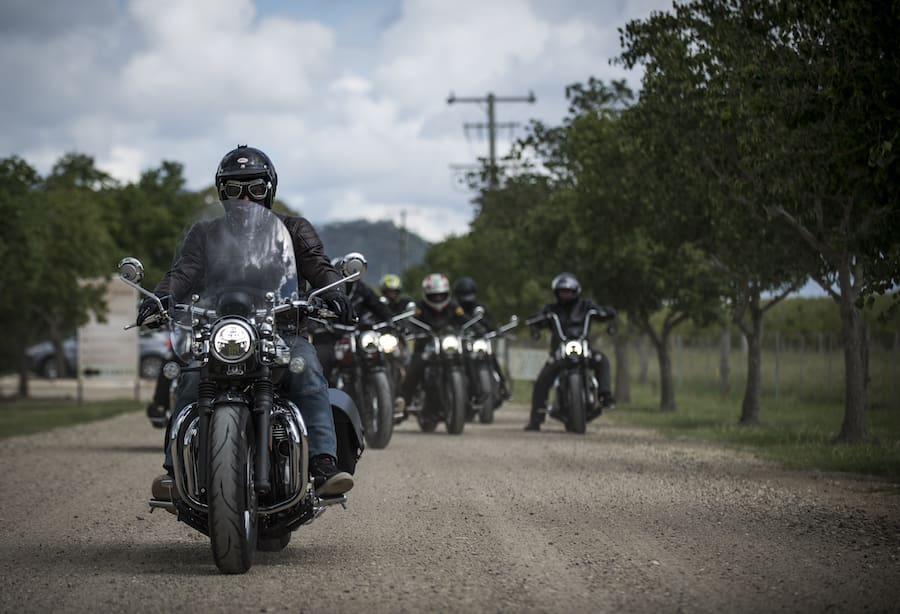
With its swept-back beach ’bars, forward-mounted ’pegs and ever-so-classy colours, the Speedmaster is a top contender, not only as a classic replica Sunday cruiser, but also as an excellent everyday runabout with its modern niceties and confidence-inspiring useability.
There’s a deep foam comfort seat and a removable pillion pad that offers versatility and top-notch comfort for you and your pillion. Tinkering and customising this bike is also on the cards, with a massive range of accessories filtering through.
The beauty of the Speedmaster is its chameleon-like qualities. You can make it look like a Bobber with the ‘Maverick’ kit one weekend, then put the standard bits back on and take a friend on the back for a picnic the next.
Three colour options are available in the Bonneville Speedmaster range, all of which complement the real metal finish, polished detailing and elegant badging.
If you’re after a classic-style cruiser with modern-day reliability, the Speedmaster needs to be experienced in its natural environment.
TEST Steve Martin
PHOTOGRAPHY Nick Wood

